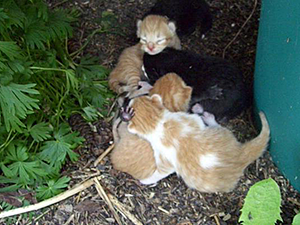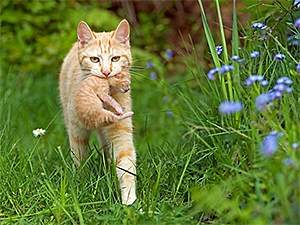What Do I Do if I Find Kittens?
You’ve found kittens! What do you do next? STOP! There’s a lot to consider when deciding if a kitten needs help. Well-meaning people do more harm than good by accidentally orphaning kittens by moving them from where they found them. A kitten’s best chance of survival is to stay with its mom.
Follow the steps below to evaluate the best move. Check out our handy flowchart here.
First: Wait & Watch
 You might have come across the kittens while their mother is off searching for food or is in the process of moving them to a different location. Try to determine if the mother is coming back for them or if they are truly orphaned.
You might have come across the kittens while their mother is off searching for food or is in the process of moving them to a different location. Try to determine if the mother is coming back for them or if they are truly orphaned.
To do this, stand far away from the kittens — 35 feet or more. If you stand too close, the mom will not approach her kittens. You might need to go away completely before the mother cat returns to attend to the kittens. It might be several hours before the mother cat returns — until she no longer senses the presence of humans hovering near her litter.
If you need to leave before the mother cat comes back, carefully evaluate whether the kittens are in immediate danger: Is it raining or snowing? Are dogs or wild animals that might harm the kittens running loose in the neighborhood? Does the neighborhood have kids or adults who are likely to harm the kittens? Are the kittens located in an area with heavy foot or car traffic?
To help with your decision, it is important to know that it might take several hours for the mother cat to return, and healthy kittens can survive this period without food as long as they are warm. Neonatal kittens are much more at risk of hypothermia than starvation. During the spring and summer months, waiting a long time to see if mom will come back is much safer than during the frigid winter months.
A great trick to use when you are leaving the kittens is called the “Flour Trick” where you sprinkle a ring of flour around the kittens and check on them periodically to see if the mother cat has returned by if there are adult sized paw prints in the flour. It is also normal for a mother cat to move her kittens so don’t be alarmed if the kittens start to go missing. A mother cat leaves her kittens alone for several reasons, ranging from needing to get food or just time for her to be alone. Monitoring the kittens for a 10-12 hour time span is ideal to give the mother cat time to feel like she can return to them safely.
The mother cat offers her kittens the best chance for survival, so wait and watch as long as possible. The best food for the kittens is their mother’s milk. Remove the kittens only if they are in immediate, grave danger.
If the mother cat returns…
 If mom returns and the area is relatively safe, leave the kittens alone with mom until they are weaned. You can offer shelter and regular food to mom, but keep the food and shelter at a distance from each other. Mom will find the food but will not accept your shelter if the food is nearby because she will not want to attract other cats to food located near her nest.
If mom returns and the area is relatively safe, leave the kittens alone with mom until they are weaned. You can offer shelter and regular food to mom, but keep the food and shelter at a distance from each other. Mom will find the food but will not accept your shelter if the food is nearby because she will not want to attract other cats to food located near her nest.
Six weeks is the optimal age to take the kittens from the mother for socialization and adoption placement, and any time after eight weeks for Trap-Neuter-Return (spay/neuter, vaccination, ear tip, and return to their colony). Female cats can become pregnant with a new litter even while they are still nursing, so don’t forget to get the mother cat spayed or you will have more kittens soon! Contact our SNIP program for assistance with low-cost spay/neutering of community cats at 828-698-4481.
If the mother cat does not return…
If you discover that mom has been hit by a car, or if it appears that she is not coming back, you should remove the kittens. This is crucial to the kittens’ survival. But please remember that their best chance of survival is NOT entering a shelter.
If you take the kittens into a shelter, there is no guarantee that volunteers will be available to take on bottle-feeding on short notice. Some prior logistical planning is usually necessary, even with organizations with experienced bottle-feeders. Even if a foster can be found, just a few hours in a shelter environment is enough to expose young kittens to a potentially deadly illness. Since the kittens’ best chance for a good outcome is to stay out of the shelter system altogether, please consider stepping up to foster the kittens yourself.
Kitten Fostering Resources
- Found Kitten Fast Facts
- Setting Up a Kitten Foster Space
- Determine Kitten Age
- General Health
- How to Bottle Feed Kittens
- When and How to Wean Kittens
- Staying on Track
- Helping Find a Home for Your Foster Kitten
- Helping a Feral Kitten Become Friendly
Kitten Fostering Supplies
Bottle Kittens (approx 0-4 weeks)
- Breeder’s Edge Feline Milk Replacer or KMR Kitten Milk Replacer (never use cow’s milk or any other substitutes)
- Pet Ag Nursing Kit
- Miracle Nipple (many kittens prefer)
- Snuggle Heating Pad Or an alternative is a DIY rice sock
- A clear plastic tub with the lid off (for kittens 0-3 weeks) or top-loading carrier
- Soft blankets (towels are not ideal as they are loopy and kitten claws will get caught on them)
- A medium-sized mesh playpen (for kittens 3-8 weeks) if you do not have a confined room to kitten proof
Weaned Kittens/General Supplies (approx four weeks and up)
- Canned Kitten Food
- Dry Kitten Chow
- Any unscented clay litter (never use clumping litter for kittens)
- Litter box and scoop (aluminum baking trays work great as a disposable option)
- A stuffed animal for comfort
- Toys (never use yarn or string as a toy for kittens)
For additional support, information, and assistance, please reach out to our Community Support Services Team at pethelpline@blueridgehumane.org or (828) 393-5832




